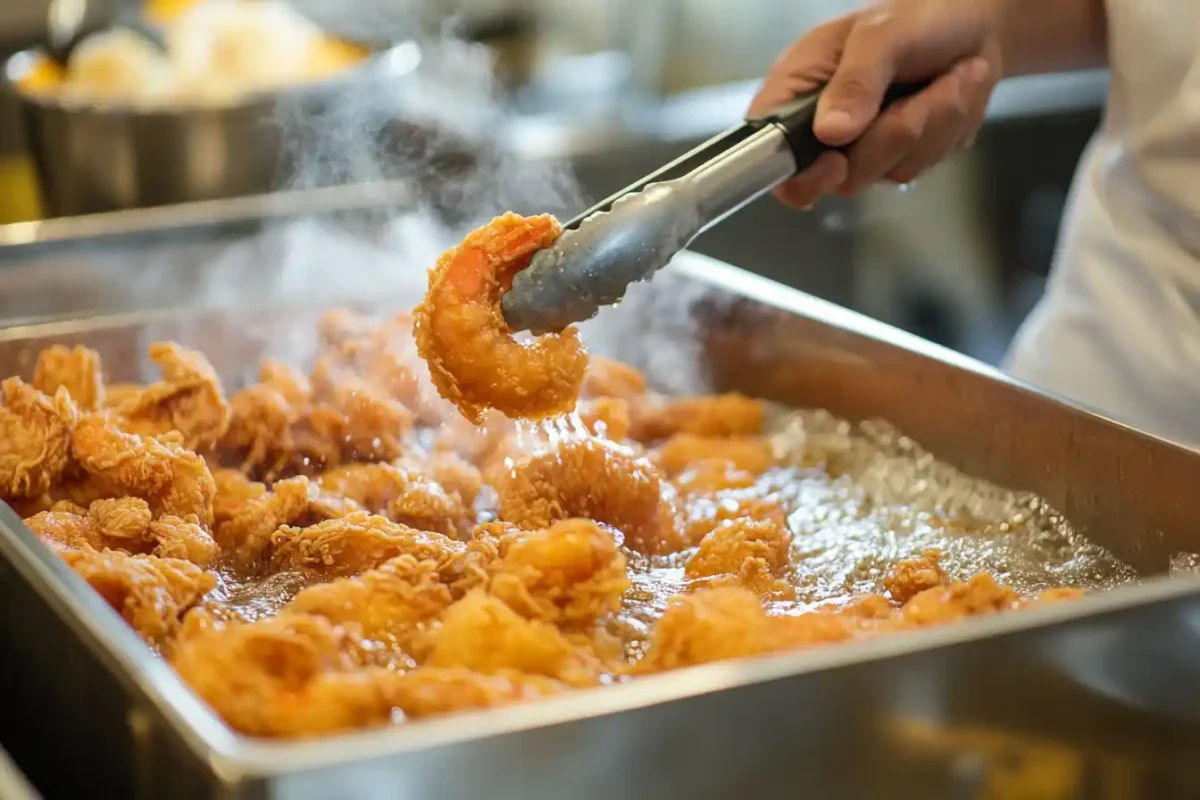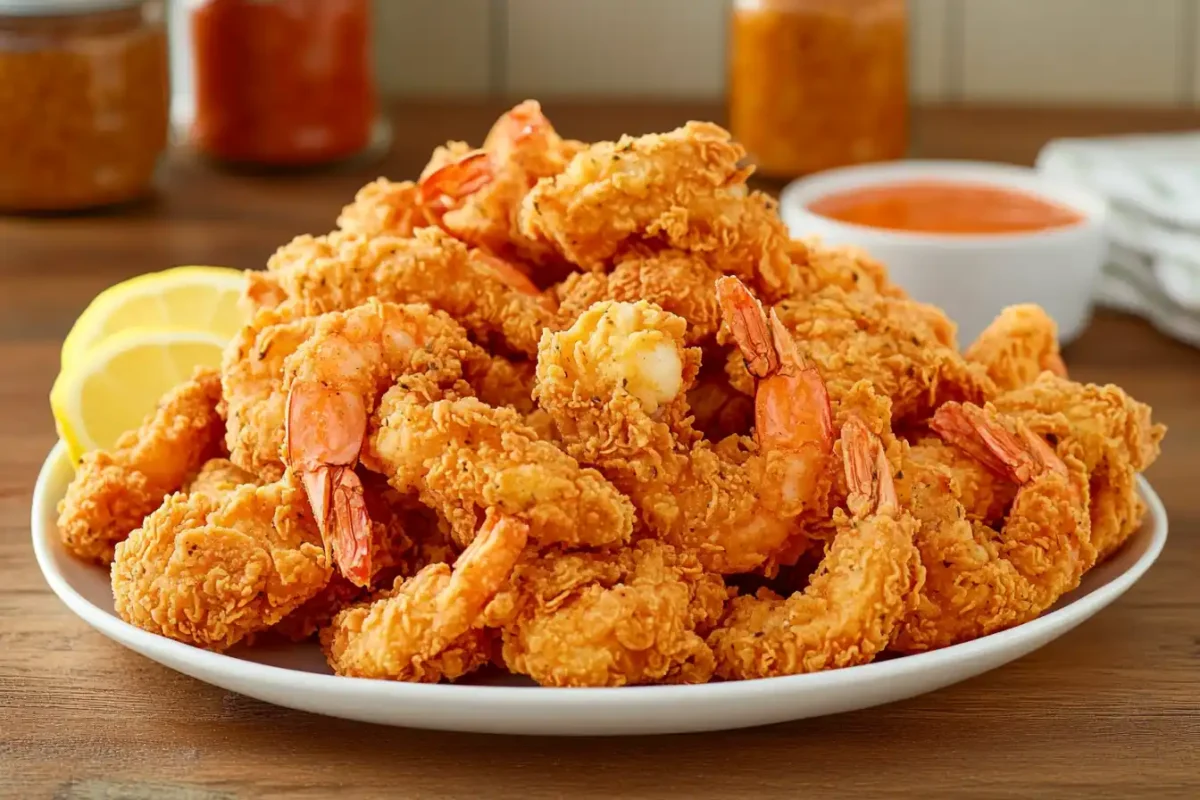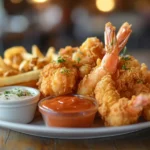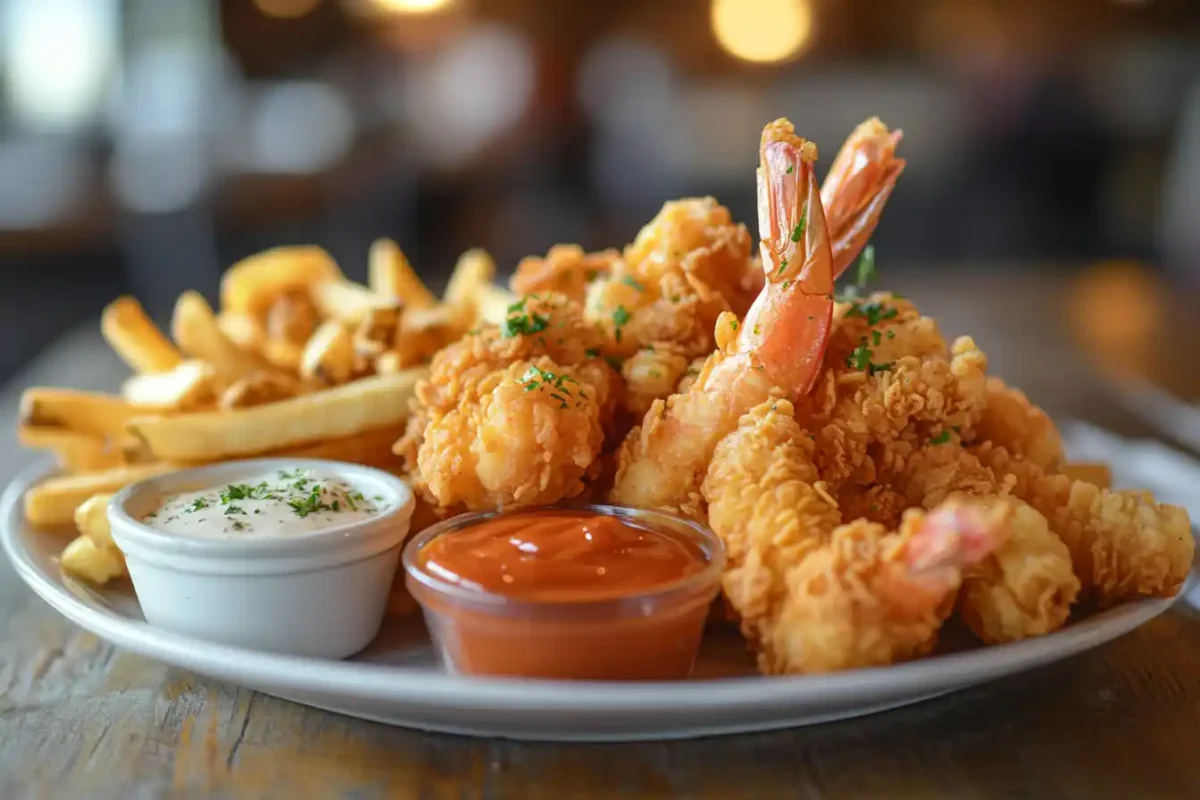If you love Popeyes, you’ve probably wondered about their cooking process. A common question that comes up is: Does Popeyes cook their chicken and shrimp together? This concern is especially important for people with food allergies, dietary restrictions, or those who just want to know how their food is prepared.
Popeyes is famous for its crispy, flavorful fried chicken and delicious seafood options, like their crunchy shrimp. But with both items being deep-fried, many customers worry about cross-contamination. If you have a shellfish allergy or just prefer your Popeyes chicken and shrimp cooked separately, this article will give you all the answers you need.
We’ll break down Popeyes’ cooking methods, how they handle allergens, and what you should know before placing your order. Whether you’re a devoted Popeyes fan or just curious, let’s dive in!
How Popeyes Cooks Their Chicken and Shrimp
Does Popeyes Fry Chicken and Shrimp in the Same Oil?
One of the biggest concerns customers have is whether Popeyes chicken and shrimp are fried in the same oil. The answer? Yes, in most locations, Popeyes uses shared fryers for both chicken and seafood.
Fast-food chains often use large commercial fryers, and it’s common for multiple items to be cooked in the same oil. At Popeyes, their fried chicken, tenders, fries, and shrimp are typically cooked in the same set of fryers. This means there is a high chance of cross-contact between different menu items.
| Food Item | Fried in Shared Oil? |
|---|---|
| Popeyes Chicken (Classic & Spicy) | Yes |
| Popeyes Shrimp | Yes |
| Popeyes Fries | Yes |
| Popeyes Fish | Yes |
Are Chicken and Shrimp Cooked Together or Separately?
While chicken and shrimp are typically fried in the same oil, they are not usually cooked in the same basket at the same time. Popeyes follows standard fast-food procedures, meaning raw chicken and seafood are handled separately before frying. However, because the oil is shared, there is always a risk of small particles from shrimp transferring into the oil used for frying chicken.
How Popeyes Maintains Flavor Consistency in Their Frying Process
Popeyes is known for its bold, Cajun-inspired flavors. They use a combination of seasoned breading and oil to create that signature crispy texture. Since the same oil is used for multiple items, flavors from different menu items can blend together over time.
This is why Popeyes chicken and shrimp have a distinct taste you might notice a slight seafood flavor in some fried items due to the shared oil. For most customers, this isn’t a big deal, but if you have a shellfish allergy, it’s something to consider.
Cross-Contamination Concerns at Popeyes

What Is Cross-Contamination and Why Does It Matter?
Cross-contamination happens when allergens or bacteria from one food transfer to another. At Popeyes, since chicken and shrimp share fryers, there is a risk of shellfish residue getting into other fried foods.
Does Popeyes Have Dedicated Fryers for Chicken and Seafood?
Unlike some restaurants that have separate fryers for seafood and non-seafood items, Popeyes typically does not. In most locations, shrimp and chicken are fried in the same oil. However, some Popeyes locations might have different kitchen setups, so it’s always best to ask your local restaurant about their frying process.
Risks for People with Shellfish Allergies
If you have a shellfish allergy, eating fried food at Popeyes could be risky. Because Popeyes chicken and shrimp share the same cooking oil, there is no guarantee that the food will be completely free of seafood traces. Even if you order just chicken, small amounts of shrimp residue could be present due to the shared oil.
For individuals with severe allergies, it’s important to be extra cautious when eating at Popeyes or any restaurant that cooks seafood and other items in the same fryers.
Popeyes’ Official Statement on Cooking Practices
Many fast-food chains provide official statements about their cooking processes, especially regarding allergens and food safety. If you’re wondering whether Popeyes chicken and shrimp are cooked together, let’s take a closer look at what the company says.
Does Popeyes Disclose Their Frying and Cooking Methods?
Popeyes provides allergen information on its official website and in-store upon request. According to their allergen guide, many of their fried items, including Popeyes chicken and shrimp, are cooked in the same fryers.
Here’s what this means:
- Popeyes does not claim to have dedicated fryers for seafood and chicken.
- There is a risk of cross-contact between shrimp, fish, chicken, and other fried items.
- People with severe allergies should avoid fried foods from Popeyes to prevent accidental exposure.
How Popeyes Addresses Allergy Concerns
Although Popeyes provides ingredient lists and allergen information, they do not guarantee an allergen-free dining experience. Unlike some fast-food brands that offer separate cooking equipment for allergen-sensitive items, Popeyes’ kitchens operate with shared fryers.
| Menu Item | Contains Shellfish? | Risk of Cross-Contamination? |
|---|---|---|
| Popeyes Fried Chicken | No | Yes |
| Popeyes Shrimp | Yes | Yes |
| Popeyes Fries | No | Yes |
| Popeyes Biscuits | No | No |
If you have a shellfish allergy, Popeyes advises against eating fried menu items. Instead, you may want to opt for non-fried items like biscuits, mashed potatoes, or coleslaw.
What Customers Should Know Before Ordering
If you are concerned about cross-contamination, here are some key takeaways before ordering from Popeyes:
- Fried foods, including chicken and shrimp, are typically cooked in shared fryers.
- Allergen information is available on the Popeyes website and in-store.
- If you have a severe shellfish allergy, avoid fried foods and ask staff for allergen-friendly options.
Comparing Popeyes’ Cooking Methods to Other Fast-Food Chains
Now that we understand Popeyes’ approach, how does it compare to other fast-food chains? Let’s examine how competitors handle chicken and shrimp cooking practices.
How Other Fast-Food Restaurants Handle Chicken and Seafood
Most fast-food restaurants that serve both chicken and seafood use shared fryers. This means that cross-contact is common. However, some brands have taken extra steps to reduce allergen exposure.
Do Other Restaurants Use Separate Fryers for Seafood?
Here’s how some well-known chains handle frying chicken and seafood:
| Fast-Food Chain | Shared Fryers? | Dedicated Seafood Fryer? |
|---|---|---|
| Popeyes | Yes | No |
| KFC | Yes | Some locations |
| Chick-fil-A | Yes (for chicken products only) | No seafood items |
| McDonald’s | Yes | Yes (for fish fillets) |
While some chains like McDonald’s may have separate fryers for seafood (e.g., for their Filet-O-Fish), Popeyes does not claim to use dedicated fryers for their shrimp and chicken.
Is Popeyes Different from Competitors Like KFC or Chick-fil-A?
Compared to other fast-food chains, Popeyes is similar to KFC in its approach. Both serve fried chicken and seafood, and both typically use shared fryers. In contrast, Chick-fil-A does not offer seafood, making it a safer option for people with shellfish allergies.
Common Problems and Solutions for Customers
By now, you know that Popeyes chicken and shrimp are fried in the same oil, which raises concerns for people with allergies, dietary restrictions, or flavor preferences. If you’re wondering how to avoid cross-contamination or find safer options at Popeyes, here are some helpful tips.
How to Avoid Cross-Contamination If You Have a Shellfish Allergy

If you have a shellfish allergy, the safest approach is to avoid fried foods at Popeyes. Since shrimp and chicken are cooked in the same fryers, it’s impossible to completely eliminate the risk of cross-contact. Instead, consider the following options:
- Stick to non-fried menu items like mashed potatoes, coleslaw, or biscuits.
- Ask the staff if any grilled or non-fried options are available at your location.
- Double-check Popeyes’ allergen menu for any updates on separate food preparation practices.
What to Ask When Ordering at Popeyes
Whenever you order at Popeyes, especially if you have dietary restrictions, it’s a good idea to ask the right questions. Here are some things you can ask the staff:
- Do you use separate fryers for chicken and shrimp?
- Are there any fried menu items that don’t come into contact with shellfish?
- What are the safest options for someone with a shellfish allergy?
Although policies may vary by location, it never hurts to ask. Employees may be able to suggest alternative meal options based on their kitchen setup.
Alternatives for Those Concerned About Shared Cooking Spaces
If you want to enjoy Popeyes but avoid the risk of cross-contamination, consider these non-fried alternatives:
| Safe Menu Item | Reason to Choose It |
|---|---|
| Biscuits | Not fried, no risk of seafood contamination |
| Mashed Potatoes (without Gravy) | Made separately from fried foods |
| Cole Slaw | A fresh, crunchy side without allergen risks |
| Red Beans and Rice | A flavorful, protein-packed option without frying |
If you’re looking for a similar fast-food experience with fewer cross-contact risks, consider Chick-fil-A or other chains that don’t serve seafood.
Expert Tips for Ordering at Popeyes
How to Request Information About Ingredients
Popeyes provides an allergen guide online, but you can also ask for one in-store. If you’re unsure about any menu item, don’t hesitate to ask an employee for clarification. Here’s how you can politely request ingredient details:
- “Hi, I have a food allergy. Could you let me know if this item comes into contact with shrimp or seafood?”
- “Do you have an allergen menu I could check before ordering?”
Most Popeyes employees are trained to answer basic allergy-related questions, but if they’re unsure, ask for a manager to assist.
Understanding Popeyes’ Menu Labels and Allergen Warnings
Popeyes’ website and in-store materials label major allergens, including shellfish, dairy, and gluten. Be sure to look for these warnings before ordering. If you see an allergen alert next to a menu item, it’s best to avoid it if you have concerns.
Safe Meal Choices for People with Food Sensitivities
For those avoiding fried foods or allergens, here are some safer meal choices at Popeyes:
- Salads (availability varies by location)
- Side orders like coleslaw, corn on the cob, and biscuits
- Drinks and desserts that don’t contain seafood-based ingredients
FAQs
Does Popeyes Use Peanut Oil for Frying?
No, Popeyes primarily uses vegetable oil, such as soybean oil, for frying. However, those with soy allergies should check with their local Popeyes to confirm the type of oil used.
Can You Order Chicken or Shrimp Cooked Separately?
In most Popeyes locations, chicken and shrimp are fried in the same oil, and there is no option to request separate cooking. However, asking your local store about their kitchen setup may provide more clarity.
Does Popeyes Have a Dedicated Menu for Allergy-Friendly Meals?
No, Popeyes does not currently offer a dedicated allergy-friendly menu. Customers with severe allergies should review the company’s allergen guide and avoid high-risk menu items.
Explore More Delicious Recipes
Final Thoughts – What You Need to Know Before Eating at Popeyes
Now that you have a complete understanding of how Popeyes chicken and shrimp are cooked, you can make informed decisions when ordering. Whether you’re concerned about allergens or just want to know more about food preparation, the key takeaways are:
- Chicken and shrimp are fried in the same oil, increasing the risk of cross-contact.
- Popeyes does not guarantee allergen-free meals.
- If you have a shellfish allergy, it’s safest to avoid fried foods at Popeyes.
- There are alternative menu items like biscuits, coleslaw, and red beans & rice.
Have you ever asked Popeyes about their cooking process? Share your experience in the comments and follow us for more food insights!
Happy cooking with Rita Chef ❤️!
Print
Popeyes Chicken and Shrimp Frying
- Total Time: One hour
- Yield: Four servings
Description
Craving the crispy and flavorful taste of Popeyes chicken and shrimp at home? This recipe delivers the perfect crunch with a well-seasoned batter, just like the famous fast-food chain. Made with juicy chicken, tender shrimp, and a spicy, crispy coating, this dish is perfect for family dinners, game nights, or weekend cravings. Serve with dipping sauces and fries for a complete meal.
Ingredients
For the Chicken and Shrimp
Two boneless skinless chicken breasts cut into strips
One cup raw shrimp peeled and deveined
For the Marinade
One cup buttermilk
One teaspoon salt
One teaspoon black pepper
One teaspoon paprika
One teaspoon garlic powder
One teaspoon hot sauce optional
For the Breading
Two cups all-purpose flour
One cup cornstarch
One tablespoon paprika
One teaspoon cayenne pepper
One teaspoon garlic powder
One teaspoon onion powder
One teaspoon salt
One teaspoon black pepper
For Frying
Four cups vegetable oil for deep frying
Instructions
Prepare the Marinade
In a large bowl whisk together buttermilk salt black pepper paprika garlic powder and hot sauce if using
Add the chicken strips and shrimp to the marinade ensuring they are fully coated
Cover and refrigerate for at least thirty minutes or up to four hours for extra flavor
Prepare the Breading
In a separate bowl mix flour cornstarch paprika cayenne pepper garlic powder onion powder salt and black pepper
Coat the Chicken and Shrimp
Remove the marinated chicken and shrimp from the buttermilk allowing excess to drip off
Dredge each piece in the seasoned flour mixture pressing gently to ensure a thick coating
Heat the Oil
In a deep frying pan or Dutch oven heat the vegetable oil over medium high heat to 350°F 175°C
Fry the Chicken and Shrimp
Carefully place the chicken pieces into the hot oil and fry for six to eight minutes until golden brown and crispy
Remove and drain on a wire rack
Next fry the shrimp for two to three minutes until crispy and cooked through
Drain excess oil on a paper towel lined plate
Serve and Enjoy
Serve hot with dipping sauces such as spicy mayo ranch or honey mustard
Pair with fries biscuits or coleslaw for a complete Popeyes-style meal
Notes
For extra crispiness double-dip the chicken and shrimp in the buttermilk and flour mixture before frying
Use a thermometer to ensure the oil stays at 350°F 175°C for the best frying results
Marinating longer enhances flavor but thirty minutes is enough for a delicious taste
- Prep Time: Forty minutes
- Cook Time: Twenty minutes
- Category: Main Dish
- Method: Deep Frying
- Cuisine: Southern Inspired
Nutrition
- Serving Size: One serving
- Calories: Four hundred eighty kcal
- Sugar: Two grams
- Sodium: Nine hundred mg
- Fat: Twenty four grams
- Saturated Fat: Six grams
- Unsaturated Fat: Sixteen grams
- Trans Fat: Zero grams
- Carbohydrates: Forty eight grams
- Fiber: Two grams
- Protein: Thirty two grams
- Cholesterol: One hundred twenty mg

